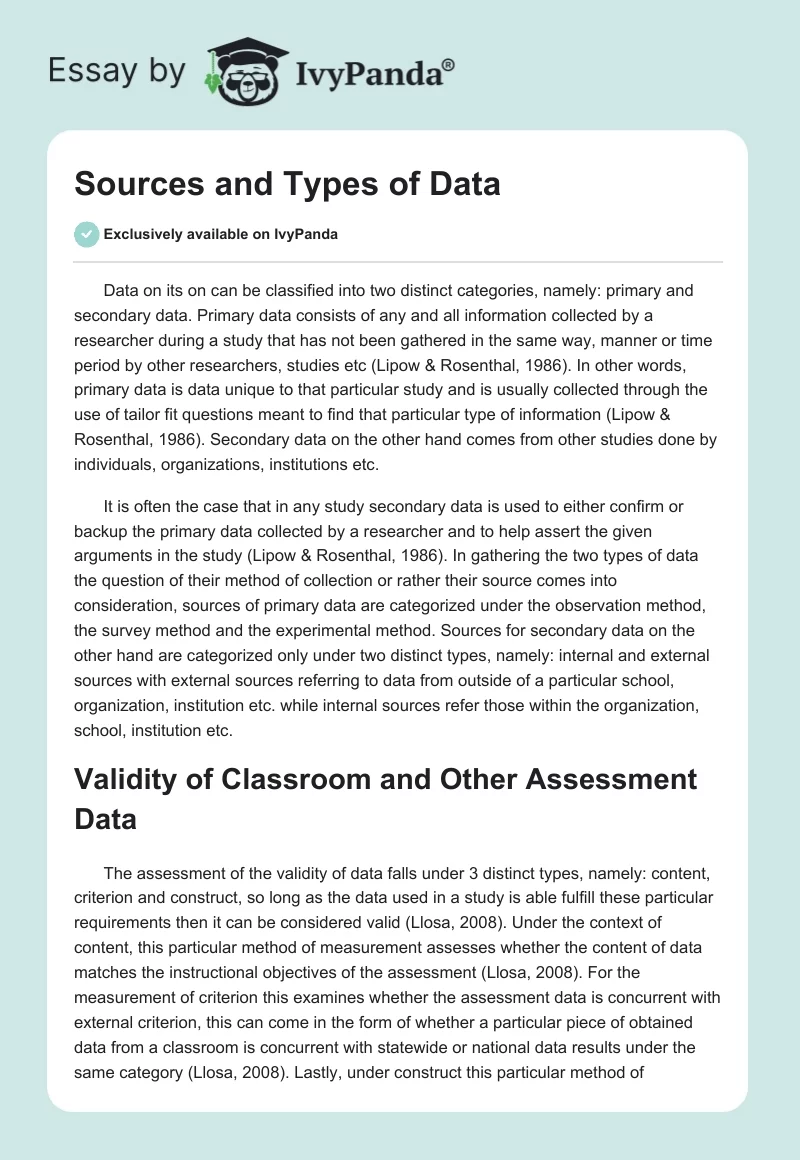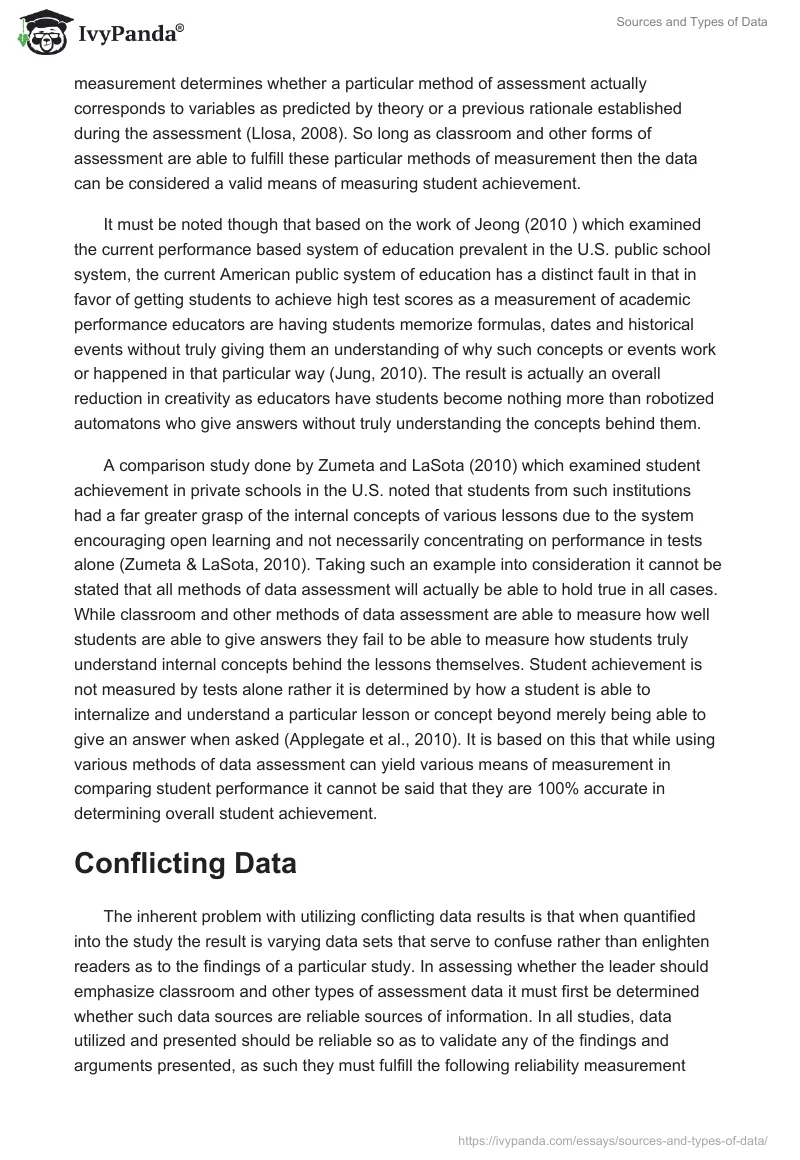Data on its on can be classified into two distinct categories, namely: primary and secondary data. Primary data consists of any and all information collected by a researcher during a study that has not been gathered in the same way, manner or time period by other researchers, studies etc (Lipow & Rosenthal, 1986). In other words, primary data is data unique to that particular study and is usually collected through the use of tailor fit questions meant to find that particular type of information (Lipow & Rosenthal, 1986). Secondary data on the other hand comes from other studies done by individuals, organizations, institutions etc.
It is often the case that in any study secondary data is used to either confirm or backup the primary data collected by a researcher and to help assert the given arguments in the study (Lipow & Rosenthal, 1986). In gathering the two types of data the question of their method of collection or rather their source comes into consideration, sources of primary data are categorized under the observation method, the survey method and the experimental method. Sources for secondary data on the other hand are categorized only under two distinct types, namely: internal and external sources with external sources referring to data from outside of a particular school, organization, institution etc. while internal sources refer those within the organization, school, institution etc.
Validity of Classroom and Other Assessment Data
The assessment of the validity of data falls under 3 distinct types, namely: content, criterion and construct, so long as the data used in a study is able fulfill these particular requirements then it can be considered valid (Llosa, 2008). Under the context of content, this particular method of measurement assesses whether the content of data matches the instructional objectives of the assessment (Llosa, 2008). For the measurement of criterion this examines whether the assessment data is concurrent with external criterion, this can come in the form of whether a particular piece of obtained data from a classroom is concurrent with statewide or national data results under the same category (Llosa, 2008). Lastly, under construct this particular method of measurement determines whether a particular method of assessment actually corresponds to variables as predicted by theory or a previous rationale established during the assessment (Llosa, 2008). So long as classroom and other forms of assessment are able to fulfill these particular methods of measurement then the data can be considered a valid means of measuring student achievement.
It must be noted though that based on the work of Jeong (2010 ) which examined the current performance based system of education prevalent in the U.S. public school system, the current American public system of education has a distinct fault in that in favor of getting students to achieve high test scores as a measurement of academic performance educators are having students memorize formulas, dates and historical events without truly giving them an understanding of why such concepts or events work or happened in that particular way (Jung, 2010). The result is actually an overall reduction in creativity as educators have students become nothing more than robotized automatons who give answers without truly understanding the concepts behind them.
A comparison study done by Zumeta and LaSota (2010) which examined student achievement in private schools in the U.S. noted that students from such institutions had a far greater grasp of the internal concepts of various lessons due to the system encouraging open learning and not necessarily concentrating on performance in tests alone (Zumeta & LaSota, 2010). Taking such an example into consideration it cannot be stated that all methods of data assessment will actually be able to hold true in all cases. While classroom and other methods of data assessment are able to measure how well students are able to give answers they fail to be able to measure how students truly understand internal concepts behind the lessons themselves. Student achievement is not measured by tests alone rather it is determined by how a student is able to internalize and understand a particular lesson or concept beyond merely being able to give an answer when asked (Applegate et al., 2010). It is based on this that while using various methods of data assessment can yield various means of measurement in comparing student performance it cannot be said that they are 100% accurate in determining overall student achievement.
Conflicting Data
The inherent problem with utilizing conflicting data results is that when quantified into the study the result is varying data sets that serve to confuse rather than enlighten readers as to the findings of a particular study. In assessing whether the leader should emphasize classroom and other types of assessment data it must first be determined whether such data sources are reliable sources of information. In all studies, data utilized and presented should be reliable so as to validate any of the findings and arguments presented, as such they must fulfill the following reliability measurement requirements: test-retests, alternate form and internal consistency. The test-retest method utilizes the same form of assessment twice yet both are given several weeks or months apart in order to judge the reliability of the results, the alternate form test on the other hand is the same as the test-retest method yet varies the items position and content slightly, the final method of measurement is internal consistency which utilizes formulas such as the Kuder-Richardson formula in order to assess the comparative results of both tests. When utilizing such methods it would be best for the leader to utilize data sets which he/she believes are consistent over a particular course of time rather than use two types of data sets with conflicting results.
Reference List
Applegate, M., Turner, J. D., & Applegate, A. J. (2010). Will the Real Reader Please Stand Up?. Reading Teacher, 63(7), 606-608.
Jung Cheol, S. (2010). Impacts of performance-based accountability on institutional performance in the U.S. Higher Education, 60(1), 47-68.
Lipow, A. G., & Rosenthal, J. A. (1986). The Researcher and the Library: A Partnership in the Near Future. Library Journal, 111(14), 154.
Llosa, L. (2008). Building and Supporting a Validity Argument for a Standards-Based Classroom Assessment of English Proficiency Based on Teacher Judgments. Educational Measurement: Issues & Practice, 27(3), 32-42
Zumeta, W., & LaSota, R. (2010). Recent Patterns in the Growth of Private Higher Education in the United States. ASHE Higher Education Report, 36(3), 91-106.


